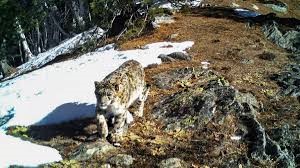About Kishtwar High Altitude National Park:
- It is located in the Kishtwar district of union territory of Jammu and Kashmir.
- The area was declared as a Kishtwar High Altitude National Park in 1980.
- It was majorly founded to protect the Snow Leopards that are now slowly vanishing from the nature.
- Physical Features:
- The area lies in the central crystalline belt of the great Himalayas and the tract is situated on the high altitudes i.e., sub-alpine and alpine zone.
- The National Park encompasses the catchment area of Kiber, Nanth and Kiyar Nallas, all of which drain south-west into Marwah River (locally called Mariv Sudir) which later joins Chenab.
- The terrain is generally rugged and steep with narrow valleys bounded by high ridges opening out in their upper glacial parts.
- It encompasses breathtaking alpine meadows, snow-capped peaks, and lush green forests, serving as a vital ecological corridor for many wildlife species.
- It is renowned for its diverse array of flora and fauna, including several rare and endangered species.
- Flora:
- It has a variety of temperature conifer forests. These include Fir, Himalayan Yew, Deodar, Blue Pine, or Kail and Spruce.
- In the alpine regions of the park extensive alpine scrub and meadows are present.
- Fauna:
- The park is a renowned snow leopard reserve. Besides, it provides a habitat for Brown bear, Himalayan musk deer, Hangul, Ibex, Wild boar, Indian muntjac, Serow Capricornis, Himalayan Tahr, Bharal etc.
Q1) Which national park is famous for Nilgiri tahr?
The Eravikulam National Park has the highest density and largest surviving population of Nilgiri tahr. The Nilgiri tahr was formerly called Hemitragus hylocrius. Its generic name was changed to Nilgiritragus after the phylogenic research by Ropiquet and Hassanin in 2005.
Source: Camera trap confirms presence of snow leopard at Kishtwar National Park
Last updated on June, 2025
→ UPSC Notification 2025 was released on 22nd January 2025.
→ UPSC Prelims Result 2025 is out now for the CSE held on 25 May 2025.
→ UPSC Prelims Question Paper 2025 and Unofficial Prelims Answer Key 2025 are available now.
→ UPSC Calendar 2026 is released on 15th May, 2025.
→ The UPSC Vacancy 2025 were released 1129, out of which 979 were for UPSC CSE and remaining 150 are for UPSC IFoS.
→ UPSC Mains 2025 will be conducted on 22nd August 2025.
→ UPSC Prelims 2026 will be conducted on 24th May, 2026 & UPSC Mains 2026 will be conducted on 21st August 2026.
→ The UPSC Selection Process is of 3 stages-Prelims, Mains and Interview.
→ UPSC Result 2024 is released with latest UPSC Marksheet 2024. Check Now!
→ UPSC Toppers List 2024 is released now. Shakti Dubey is UPSC AIR 1 2024 Topper.
→ Also check Best IAS Coaching in Delhi






















